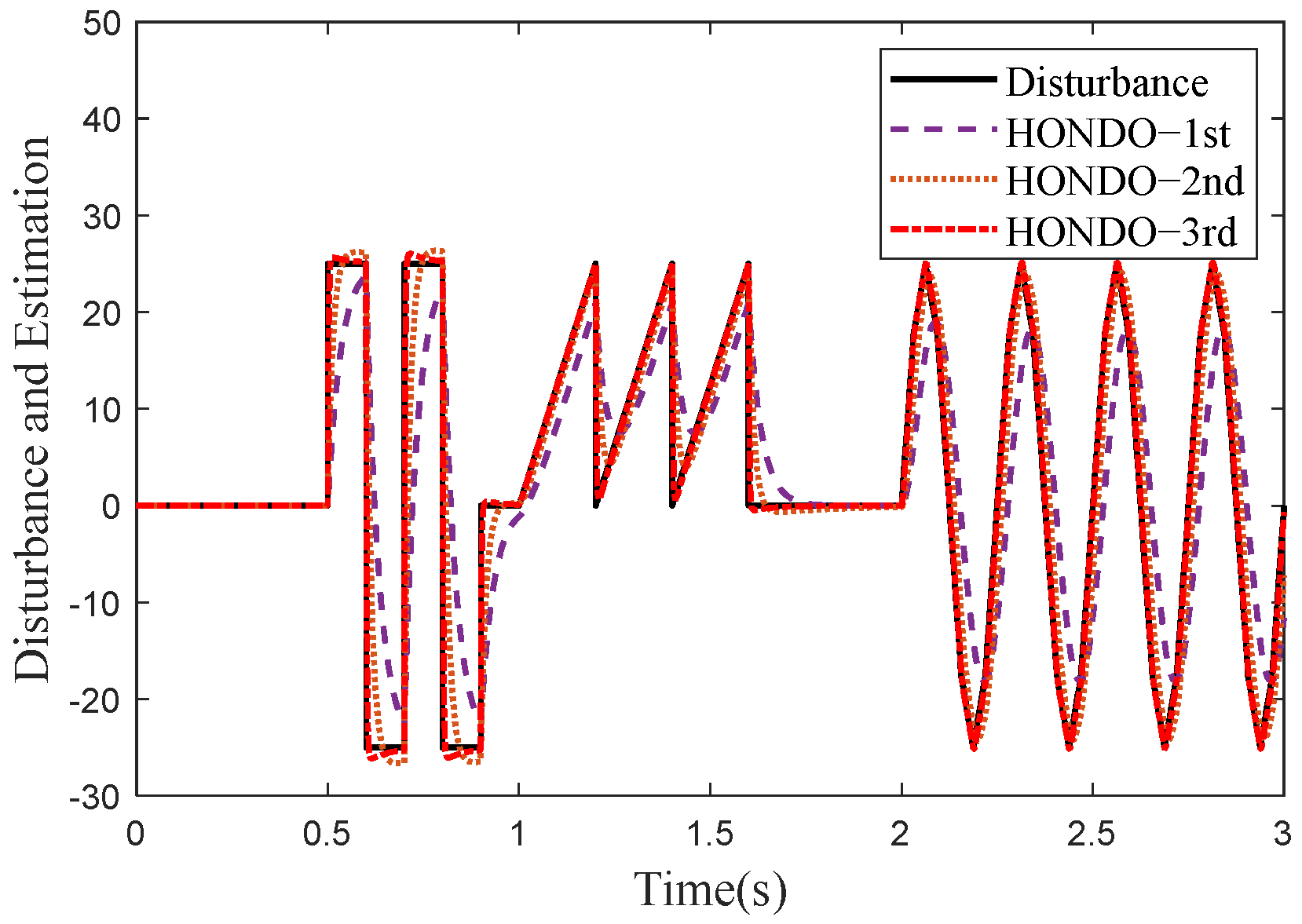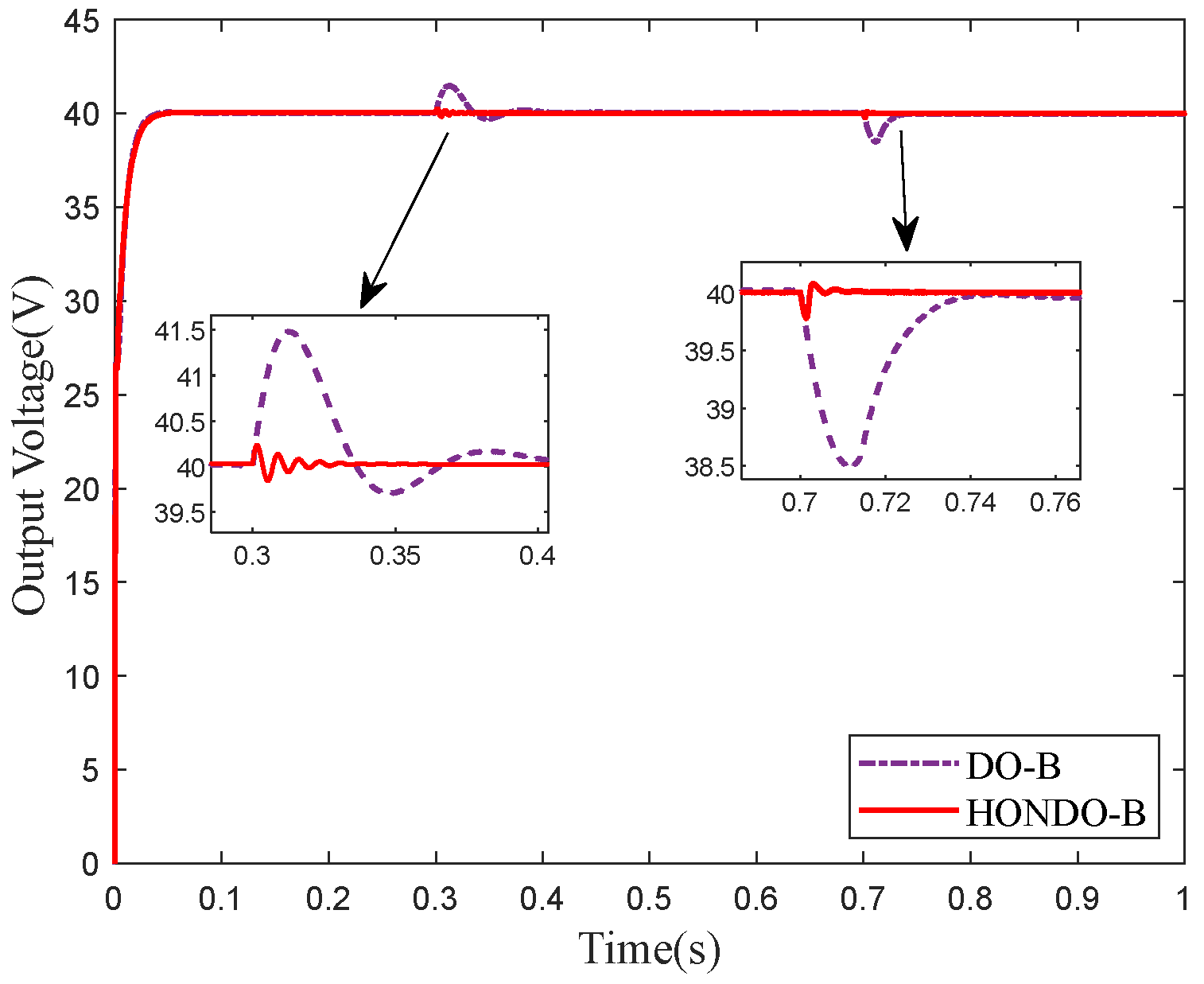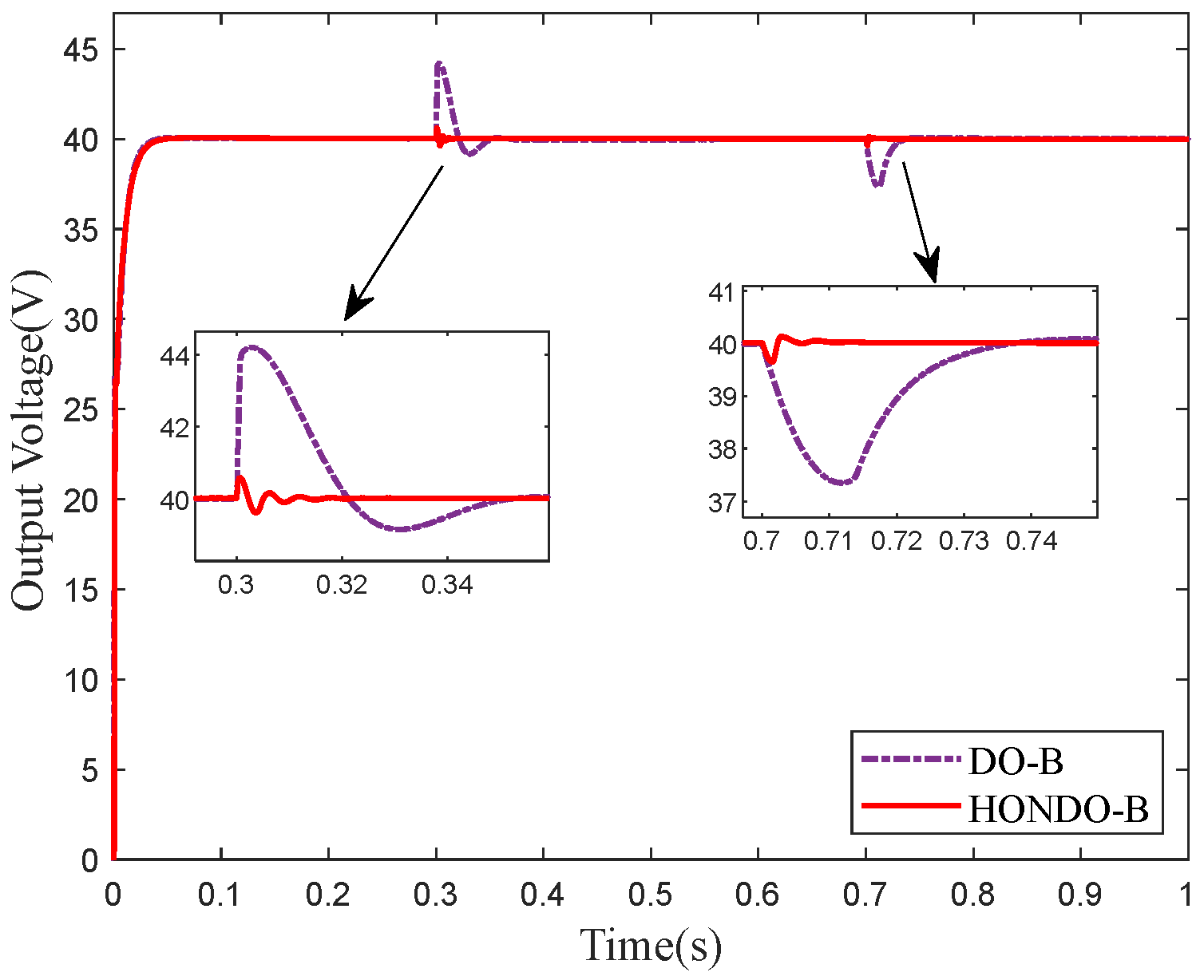Anti-Interference Control Method of Buck–Boost Converter Based on High-Order Nonlinear Disturbance Observer
Abstract
1. Introduction
- (1)
- Consider system disturbances and parameter uncertainties, establish system dynamic equations, and introduce nominal values to simplify the system model. Design dual high-order nonlinear disturbance observers for voltage and current loops based on dynamic equations, estimate the disturbance of the Buck–Boost circuit in rea-time, and provide compensation, thereby improving the system’s anti-interference ability against high-order disturbances;
- (2)
- Design a backstepping disturbance rejection controller based on a high-order nonlinear disturbance observer to achieve good tracking of the system output voltage reference value and improve system response speed;
- (3)
- By combining a dual high-order nonlinear disturbance observer with a backstepping controller to form a composite disturbance rejection controller, the proposed control method can eliminate the influence of model parameter uncertainty, have a wider disturbance rejection range, and effectively improve the robustness and dynamic performance of the Buck–Boost converter in microgrid applications.
2. Modeling of the Buck–Boost Converter
3. Design of High-Order Nonlinear Disturbance Observer
3.1. First-Order Nonlinear Disturbance Observer
3.2. Second-Order Nonlinear Disturbance Observer
3.3. High-Order Nonlinear Disturbance Observer
4. Backstepping Controller Based on High-Order Nonlinear Disturbance Observer
5. Simulation and Experimental Verification
5.1. Simulation Results
5.2. Experimental Results
6. Conclusions
Author Contributions
Funding
Data Availability Statement
Conflicts of Interest
References
- Heidary, J.; Gheisarnejad, M.; Khooban, M.H. Stability Enhancement and Energy Management of AC-DC Microgrid based on Active Disturbance Rejection Control. Electr. Power Syst. Res. 2023, 217, 109105. [Google Scholar] [CrossRef]
- Zhou, K.; Qiu, X.; Song, Y.; Jin, Q.; Mo, Z. Research on Coordinated DC voltage Control Strategy of DC Microgrid based on Photovoltaic Power Generation System. J. Phys. Conf. Ser. 2022, 2246, 012066. [Google Scholar] [CrossRef]
- Martinez-Trevino, B.A.; El Aroudi, A.; Valderrama-Blavi, H.; Cid-Pastor, A.; Vidal-Idiarte, E.; Martinez-Salamero, L. PWM nonlinear control with load power estimation for output voltage regulation of a boost converter with constant power load. IEEE Trans. Power Electron. 2020, 36, 2143–2153. [Google Scholar] [CrossRef]
- Guo, Q.; Bahri, I.; Diallo, D.; Berthelot, E. Model predictive control and linear control of DC-DC boost converter in low voltage DC microgrid: An experimental comparative study. Control Eng. Pract. 2023, 131, 105387. [Google Scholar] [CrossRef]
- Rajamani, M.P.E.; Rajesh, R.; Iruthayarajan, M.W. A PID control scheme with enhanced non-dominated sorting genetic algorithm applied to a non-inverting buck-boost converter. Sadhana Acad. Proc. Eng. Sci. 2022, 47, 222. [Google Scholar] [CrossRef]
- Molina-Santana, E.; Gonzalez-Montañez, F.; Liceaga-Castro, J.U.; Jimenez-Mondragon, V.M.; Siller-Alcala, I. Modeling and Control of a DC-DC Buck–Boost Converter with Non-Linear Power Inductor Operating in Saturation Region Considering Electrical Losses. Mathematics 2023, 11, 4617. [Google Scholar] [CrossRef]
- Kasicheyanula, S.; John, V. Adaptive control strategy for ultracapacitor based bidirectional dc-dc converters. IEEE Trans. Ind. Appl. 2018, 55, 1717–1728. [Google Scholar] [CrossRef]
- Cortajarena, J.A.; Barambones, O.; Alkorta, P.; Cortajarena, J. Sliding mode control of an active power filter with photovoltaic maximum power tracking. Int. J. Electr. Power Energy Syst. 2019, 110, 747–758. [Google Scholar] [CrossRef]
- Soriano-Sánchez, A.G.; Rodríguez-Licea, M.A.; Pérez-Pinal, F.J.; Vázquez-López, J.A. Fractional-Order Approximation and Synthesis of a PID Controller for a Buck Converter. Energies 2020, 13, 629. [Google Scholar] [CrossRef]
- Rajendran, S.; Thangavel, V.; Krishnan, N.; Prabaharan, N. DC Link Voltage Enhancement in DC Microgrid Using PV Based High Gain Converter with Cascaded Fuzzy Logic Controller. Energies 2023, 16, 3928. [Google Scholar] [CrossRef]
- Zheng, S.; Qi, M.; Shu, Y.; Wang, Y.; Lang, J. Non-singular terminal sliding mode control strategy for DC/DC Boost converter system using a finite-time convergent observer. IET Power Electron. 2022, 15, 1868–1876. [Google Scholar] [CrossRef]
- Samantaray, J.; Chakrabarty, S.; Bartoszewicz, A. Advanced discrete-time sliding mode control with fast output sampling and its application to buck converter. Automatica 2023, 149, 110802. [Google Scholar] [CrossRef]
- Abjadi, N.; Goudarzian, A.; Markadeh, G.R.A.; Valipour, Z. Reduced-Order Backstepping Controller for POESLL DC–DC Converter Based on Pulse Width Modulation. Iran. J. Sci. Technol. Trans. Electr. Eng. 2019, 43, 219–228. [Google Scholar] [CrossRef]
- Chaudhari, S.; Shendge, P.D.; Phadke, S.B. Disturbance Observer Based Controller Under Noisy Measurement for Tracking of nDOF Uncertain Mismatched Nonlinear Interconnected Systems. IEEE/ASME Trans. Mechatron. 2020, 25, 1600–1611. [Google Scholar] [CrossRef]
- Chen, W.H. Disturbance observer based control for nonlinear systems. IEEE/ASME Trans. Mechatron. 2004, 9, 706–710. [Google Scholar] [CrossRef]
- Yang, J.; Li, S.; Yu, X. Sliding-Mode Control for Systems With Mismatched Uncertainties via a Disturbance Observer. IEEE Trans. Ind. Electron. 2013, 60, 160–169. [Google Scholar] [CrossRef]
- Wang, R.; Mei, L.; Zhang, G. Disturbance Observer-Based Sliding Mode Control for DC-DC Boost Converter. In Proceedings of the 2018 IEEE 3rd Advanced Information Technology, Electronic and Automation Control Conference (IAEAC), Chongqing, China, 12–14 October 2018. [Google Scholar] [CrossRef]
- Kobaku, T.; Jeyasenthil, R.; Sahoo, S.; Dragicevic, T. Experimental Verification of Robust PID Controller Under Feedforward Framework for a Nonminimum Phase DC–DC Boost Converter. IEEE J. Emerg. Sel. Top. Power Electron. 2021, 9, 3373–3383. [Google Scholar] [CrossRef]
- Errouissi, R.; Shareef, H.; Viswambharan, A.; Wahyudie, A. Disturbance Observer-Based Control for DC-DC Boost Converter. In Proceedings of the 2021 IEEE Industry Applications Society Annual Meeting (IAS), Vancouver, BC, Canada, 10–14 October 2021; pp. 1–6. [Google Scholar]
- Mollaee, H.; Ghamari, S.M.; Saadat, S.A.; Wheeler, P. A novel adaptive cascade controller design on a buck–boost DC–DC converter with a fractional-order PID voltage controller and a self-tuning regulator adaptive current controller. IET Power Electron. 2021, 14, 1920–1935. [Google Scholar] [CrossRef]
- Hassan, M.A.; Su, C.L.; Chen, F.Z.; Lo, K.Y. Adaptive Passivity-Based Control of DC-DC Boost Power Converter Supplying Constant Power and Constant Voltage Loads. IEEE Trans. Ind. Electron. 2021, 69, 6204–6214. [Google Scholar] [CrossRef]
- Saadat, S.A.; Ghamari, S.M.; Mollaee, H. Adaptive backstepping controller design on Buck converter with a novel improved identification method. IET Control. Theory Appl. 2022, 16, 485–495. [Google Scholar] [CrossRef]












| Parameter | Value |
|---|---|
| Input voltage (Vin0) | 60 V |
| Reference voltage (vref) | 40 V |
| Switching frequency (f0) | 50 kHz |
| Inductance (L0) | 275 µH |
| Capacitance (C0) | 47 µF |
| Load resistance (R0) | 50 Ω |
| Control Method | Load Mutation | Input Voltage Mutation | ||||
|---|---|---|---|---|---|---|
| OS (V) | US (V) | Adjust Time (s) | OS (V) | US (V) | Adjust Time (s) | |
| DO-B | 1.15 | 2.16 | 0.0018 | 3.04 | - | 0.016 |
| HONDO-B | 0.34 | 1.08 | 0.001 | 1.09 | - | 0.006 |
Disclaimer/Publisher’s Note: The statements, opinions and data contained in all publications are solely those of the individual author(s) and contributor(s) and not of MDPI and/or the editor(s). MDPI and/or the editor(s) disclaim responsibility for any injury to people or property resulting from any ideas, methods, instructions or products referred to in the content. |
© 2024 by the authors. Licensee MDPI, Basel, Switzerland. This article is an open access article distributed under the terms and conditions of the Creative Commons Attribution (CC BY) license (https://creativecommons.org/licenses/by/4.0/).
Share and Cite
Chang, Y.; Yu, W.; Luo, M.; Zhou, F.; Huang, W.; Zhai, G. Anti-Interference Control Method of Buck–Boost Converter Based on High-Order Nonlinear Disturbance Observer. Electronics 2024, 13, 1318. https://doi.org/10.3390/electronics13071318
Chang Y, Yu W, Luo M, Zhou F, Huang W, Zhai G. Anti-Interference Control Method of Buck–Boost Converter Based on High-Order Nonlinear Disturbance Observer. Electronics. 2024; 13(7):1318. https://doi.org/10.3390/electronics13071318
Chicago/Turabian StyleChang, Yufang, Wenjin Yu, Mengyao Luo, Feifei Zhou, Wencong Huang, and Guisheng Zhai. 2024. "Anti-Interference Control Method of Buck–Boost Converter Based on High-Order Nonlinear Disturbance Observer" Electronics 13, no. 7: 1318. https://doi.org/10.3390/electronics13071318
APA StyleChang, Y., Yu, W., Luo, M., Zhou, F., Huang, W., & Zhai, G. (2024). Anti-Interference Control Method of Buck–Boost Converter Based on High-Order Nonlinear Disturbance Observer. Electronics, 13(7), 1318. https://doi.org/10.3390/electronics13071318






